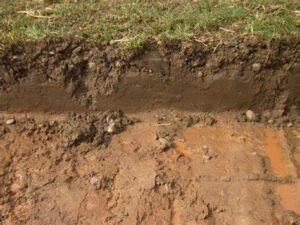In previous articles, we have discussed the challenges of cohesive soil conditions and how to combat them. This time, we will focus on the opposite end of the spectrum: granular soils, specifically sand. Sand presents its own set of difficulties when it comes to underground boring. However, with the use of bentonite clay, Prairie Dog Underground Boring Equipment provides an effective solution. In this blog post, we will delve into the properties of sand and bentonite clay, and how they can be managed in borehole operations.

Understanding Sand and Its Challenges
Sand is characterized by large, uneven particles that do not bind together well. Due to their individual weight and voids within the particles, sand does not stick together easily. When water enters these voids, it weighs down the mass and can cause the collapse of the borehole. This collapse does not occur solely from the weight of the sand itself, but rather from the sand being weighed down by water. As a result, the sand rests on top of the drill string, hindering rotation and lateral movement. This situation can lead to stuck rods and render the borehole useless.

The Role of Bentonite Clay
Bentonite clay has long been used in vertical and horizontal drilling to prevent hole collapse. Its unique properties allow it to create a seal that prevents the absorption of excess water by the ground, thus preventing sand collapse due to water weight. When applied, bentonite forms what is known as a filter cake, serving as a protective shield. By coating the sand and blocking further water absorption, bentonite effectively maintains the integrity of the borehole.
Utilizing Bentonite with Prairie Dog Machines
Prairie Dog Underground Boring Equipment makes it easy to incorporate bentonite into the drilling process. A proper mixture of bentonite and water can be easily pumped through a Prairie Dog boring machine. All you need is a small centrifugal water pump connected to a tank that holds the required amount of water (typically 250 – 300 gallons, though 55-gallon drums can also be used). By plumbing the pump with valves, you can circulate the water and bentonite to ensure thorough mixing before diverting the mixture to the machine. As demonstrated in a YouTube video (link provided), the bentonite mixture does not need to be excessively thick or viscous; it simply needs to coat the sand to block absorption.

Advantages and Cost-Effectiveness
In the majority of bore operations carried out with Prairie Dog machines, drilling fluids are not necessary. However, in certain cases, additives may be required to keep the drill string moving or the borehole open, particularly with wet bore machines. Wet bore machines, like those from Prairie Dog, offer numerous advantages, including the ability to work in a wider range of soil conditions, increased accuracy, comparable or faster speeds compared to air missiles, less depth requirement for surface upheaval prevention, and the use of drilling fluids.
Accessing Bentonite and Drilling Mud Suppliers
Both bentonite clay and drilling fluids are cost-effective solutions when faced with challenging soil conditions, whether it be difficult clay or sand. To find these products, you can reach out to local drilling mud suppliers or visit Baroid IDP. Alternatively, you can contact Prairie Dog Boring Equipment at 866-631-3786 for assistance in locating a local supplier.
By utilizing Prairie Dog Underground Boring Equipment alongside bentonite clay or drilling fluids, you can overcome the challenges posed by sand and ensure successful borehole operations.
Prairie Dog Underground Boring Equipment, sand challenges, bentonite clay, drilling fluids, borehole operations

